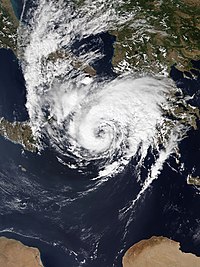
Photo from wikipedia
Funding information Submitted on July 28, 2019 Revised onDecember 27, 2019 For tropical rainfall, there are several potential sources of predictability, including synoptic-scale convectively coupled equatorial waves (CCEWs) and intraseasonal… Click to show full abstract
Funding information Submitted on July 28, 2019 Revised onDecember 27, 2019 For tropical rainfall, there are several potential sources of predictability, including synoptic-scale convectively coupled equatorial waves (CCEWs) and intraseasonal oscillations such as theMadden–Julian Oscillation (MJO). In prior work, predictability of these waves and rainfall has mainly been explored using forecast model data. Here the goal is to estimate the intrinsic predictability using, instead, mainly observational data. To accomplish this, Tropical Rainfall MeasuringMission (TRMM) data is decomposed into different wave types using spectral/Fourier filtering. Predictability ofMJO rainfall is estimated to be 22 to 31 days, depending on longitude, asmeasured by the lead timewhen pattern correlation skill drops below 0.5. Predictability of rainfall associated with convectively coupled equatorial Rossbywaves, Kelvin waves, and a background spectrum or non-wave component are estimated to be 8 to 12 days, 2 to 3 days and 0 to 3 days, respectively. Combining all wave types, the overall predictability of tropical rainfall is estimated to be 3 to 6 days, over the Indian and Pacific Ocean regions, and on equatorial synoptic and planetary length scales. For comparison, outgoing longwave radiation (OLR) wasmore predictable than rainfall by 5 to 10 days over these regions. Wave-removal tests were also conducted to estimate the contribution of each wave type to the overall predictability of rainfall. In
Journal Title: Quarterly Journal of the Royal Meteorological Society
Year Published: 2020
Link to full text (if available)
Share on Social Media: Sign Up to like & get
recommendations!